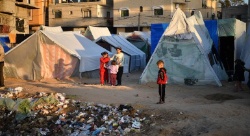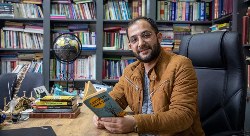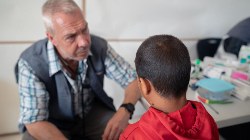Lebanon’s Cultural Heritage Largely Survived Bombs
Lebanon’s Cultural Heritage Largely Survived Recent Bombing, Say UN Experts
New York, Sep 18 2006 5:00PM
Most components of Lebanon’s cultural heritage were spared during the recent conflict, experts sent by the United Nations Educational, Scientific and Cultural Organization (UNESCO) said today after visiting the country, but urgent measures are needed to protect the Worlῤ Heritage List site of Byblos from the effects of an oil spill.
At a press conference at UNESCO’s headquarters in Paris following the six-day assessment visit by the experts, the mission’s leader Mounir Bouchenaki said the World Heritage List sites of Baalbek and Tyre sustained only minor damage.
But Mr. Bouchenaki, who is also Director-General of the International Centre for the Study of the Preservation and Restoration of Cultural Property, said the most serious damage occurred at Byblos, which contains the ruins of an important city of the Phoenician civilization.
The Israeli Defence Forces (IDF) bombed a coastal power plant at Jiyeh during its conflict with Hizbollah, causing an oil spill in the eastern Mediterranean sea that has reached Byblos.
Mr. Bouchenaki said the stones at the base of two mediaeval towers and other seashore archaeological remains in the port have been affected by the oil spill. He estimated the clean-up operation will take up to 10 weeks, involve 25 people and cost about $100,000.
In Tyre, while the Roman hippodrome and triumphal arch were undamaged, several frescoes in a Roman tomb on the site had come partly unstuck and needed restoration, Mr. Bouchenaki said.
At Baalbek, the site was spared apart from the fall of one block of stone and suspected widening fissures on the lintels of the temples of Jupiter and Bacchus. In the nearby Old City of Baalbek, which is not part of the property inscribed on the World Heritage List, bombs damaged the souk and some old houses.
The experts also visited the Old City of Saida and the nearby Temple of Echmoun – which the Lebanese Government is preparing to propose for inscription on the World Heritage List – and found them unscathed from the conflict.
Stressing the importance that cultural heritage plays in demonstrating Lebanon’s diversity and tolerance, UNESCO Assistant Director-General for Culture Françoise Rivière told today’s press conference that the World Heritage Fund could set aside $70,000 in emergency spending to help the country.
Aside from Mr. Bouchenaki, the experts who took part in the mission were: Alain Bouineau, Honorary Professor at the Jean Monnet University of St. Etienne, France; Giorgio Croci, Professor at La Sapienza University, Rome; Véronique Dauge, head of the Arab States unit at UNESCO’s World Heritage Centre; Joseph Kreidi, culture project officer at UNESCO's Beirut office; and Tamara Teneishivili, cultural programme specialist at UNESCO's Beirut office.
Ends


 UN News: 10,000 People Feared Buried Under The Rubble In Gaza
UN News: 10,000 People Feared Buried Under The Rubble In Gaza Save The Children: Heat-stricken Bangladesh Extends School Closures
Save The Children: Heat-stricken Bangladesh Extends School Closures Hayden Stephens and Associates: Record Class Action Settlement Gives Hope To 50,000 Australian Junior Doctors
Hayden Stephens and Associates: Record Class Action Settlement Gives Hope To 50,000 Australian Junior Doctors UN News: Healing Page By Page In Earthquake-affected Türkiye
UN News: Healing Page By Page In Earthquake-affected Türkiye Save The Children: Rate Of Attacks On Healthcare in Gaza Higher Than In Any Other Conflict Since 2018
Save The Children: Rate Of Attacks On Healthcare in Gaza Higher Than In Any Other Conflict Since 2018 UN News: Green Light For New Cholera Vaccine, Ukraine Attacks Condemned, Action Against Racism
UN News: Green Light For New Cholera Vaccine, Ukraine Attacks Condemned, Action Against Racism